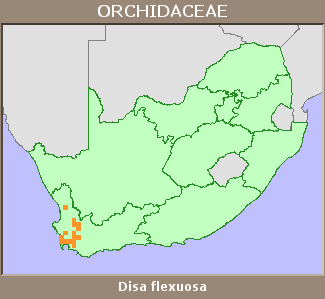|
Scientific Name | Disa flexuosa (L.) Sw. |
Higher Classification | Monocotyledons |
Family | ORCHIDACEAE |
Synonyms | Orchis flexuosa L., Satyrium flexuosum (L.) Thunb., Schizodium flexuosum (L.) Lindl. |
Common Names | Bacon-And-Eggs (e) |
National Status |
Status and Criteria | Near Threatened B1ab(ii,iii,v) |
Assessment Date | 2006/10/02 |
Assessor(s) | L. von Staden |
Justification | Of the 36 recorded herbarium collection localities, 10 are old and have locality descriptions that are too vague to be able to determine if subpopulations are still extant. Of the 16 precise locations, 50% have been lost to urban development and agriculture over the past 70 years. The generation length of this species is unfortunately not known. EOO is between 9 065 and 34 970 km², and there are between three and 16 extant locations. Decline due to further crop cultivation, invasive alien plants and eutrophication of wetlands is continuing. |
Distribution |
Endemism | South African endemic |
Provincial distribution | Northern Cape, Western Cape |
Range | Western Cape lowlands, from Nieuwoudtville southwards to Caledon and eastwards to Hex River Valley. Extinct on the Cape Peninsula. |
Habitat and Ecology |
Major system | Terrestrial |
Major habitats | Breede Shale Renosterveld, Ceres Shale Renosterveld, Winterhoek Sandstone Fynbos, Cederberg Sandstone Fynbos, Breede Shale Fynbos, Breede Sand Fynbos, Breede Alluvium Fynbos, Kouebokkeveld Alluvium Fynbos |
Description | Seasonally moist, sandy flats, sometimes along streams. |
Threats |
| This species has declined substantially in the past, with ± 50% of the known localities now extinct, but may be more, as many older localities from herbarium records need confirmation on whether subpopulations are still extant.
Decline across the entire species' range has mainly been due to agriculture (crop cultivation), crop cultivation remains an ongoing threat (B. Bytebier, pers. comm.)
In some areas, e.g. around Stellenbosch and the Cape Flats, some localities/subpopulations are now extinct due to urban development.
Seasonally moist wetland habitats are especially vulnerable to invasion by invasive alien plant species, especially within agricultural landscapes where eutrophication of wetlands enhance the ability of alien grasses to colonize and take over wetland habitats. Alien acacias, especially black wattle, are still a big problem along river courses, although efforts have been made to clear these in some areas. |
Population |
Not much data is available on subpopulation structure. Herbarium notes range from locally common to rare. B. Bytebier estimates there are about 50 plants at Riverlands, but this is difficult to confirm as plants occur as scattered individuals across the reserve.
|
Population trend | Decreasing |
Conservation |
| Oorlogskloof Nature Reserve
Riverlands Nature Reserve
Hottentots Holland Nature Reserve |
Assessment History |
Taxon assessed |
Status and Criteria |
Citation/Red List version | | Schizodium flexuosum (L.) Lindl. | NT B1ab(ii,iii,v) | Raimondo et al. (2009) | |
Bibliography |
Liltved, W.R. and Johnson, S.D. Unpublished. The Cape Orchids - Wild orchids of the Cape Floral Kingdom.
Linder, H.P. 1981. Taxonomic studies in the Disinae. III. A revision of Disa Berg. excluding sect. Micranthae Lindl. Contributions from the Bolus Herbarium 9:1-370.
Linder, H.P. and Kurzweil, H. 1999. Orchids of southern Africa. A.A. Balkema, Rotterdam.
Raimondo, D., von Staden, L., Foden, W., Victor, J.E., Helme, N.A., Turner, R.C., Kamundi, D.A. and Manyama, P.A. 2009. Red List of South African Plants. Strelitzia 25. South African National Biodiversity Institute, Pretoria.
|
Citation |
| von Staden, L. 2006. Disa flexuosa (L.) Sw. National Assessment: Red List of South African Plants version 2024.1. Accessed on 2025/10/30 |
 Comment on this assessment
Comment on this assessment

